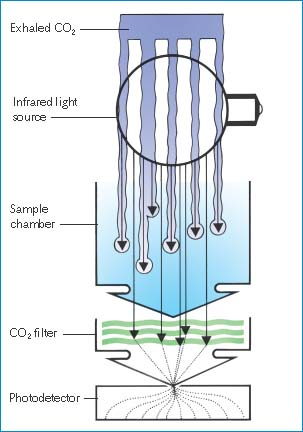End-Tidal Carbon Dioxide Monitoring
End-tidal carbon dioxide (ETCO2) determines the carbon dioxide (CO2) concentration in exhaled gas to provide information about a patient’s pulmonary, cardiac, and metabolic status. Such information aids patient management and helps prevent clinical compromise.
In ETCO2 monitoring, a photodetector measures the amount of infrared light absorbed by airway gas during inspiration and expiration. (Light absorption increases along with the CO2 concentration.) A monitor converts these data to a CO2 value and a corresponding waveform, or capnogram, if capnography is used. (See How ETCO2 monitoring works.) The sensor is positioned at one of two sites in the monitoring setup. With a mainstream monitor, it’s positioned directly at the patient’s airway with an airway adapter, between the endotracheal (ET) tube and the breathing circuit tubing. With a sidestream monitor, the airway adapter is positioned at the airway (regardless of whether or not the patient is intubated) to allow aspiration of gas from the patient’s airway back to the sensor, which lies either within or close to the monitor.
Some CO2 detection devices provide semiquantitative indications of CO2 concentrations, supplying an approximate range rather than a specific value for ETCO2. Other devices simply indicate whether CO2 is present during exhalation. (See Analyzing CO2 levels, page 270.)
The 2010 American Heart Association guidelines for cardiopulmonary resuscitation and emergency cardiovascular care recommend ETCO2 monitoring in combination with clinical assessment to confirm initial ET tube placement in the patient in cardiac arrest when continuous quantitative waveform capnography isn’t available.1
ETCO2 monitoring has become standard during anesthesia administration, such as in patients who are undergoing moderate sedation. It may also be used in those receiving epidural or patient-controlled analgesia for pain control. The ETCO2 measurements can alert the nurse to hypoventilation from oversedation.2
When ETCO2 is detected during cardiac arrest, it’s a good indicator that the ET tube is properly placed in the trachea. However, such conditions as pulmonary embolus, pulmonary edema, status asthmaticus, or gastric content contamination of the ETCO2 detector may produce false results. Therefore, if CO2 isn’t detected, a second method should be used to confirm ET tube placement, such as direct visualization or use of an esophageal detector device.1
Equipment
Gloves ▪ mainstream or sidestream CO2 monitor ▪ CO2 sensor ▪ airway adapter, as recommended by the manufacturer (a neonatal adapter may have a much smaller dead space, making it appropriate for a smaller patient) ▪ ETCO2 sensor.
How ETCO2 Monitoring Works
The optical portion of an end-tidal carbon dioxide (ETCO2) monitor contains an infrared light source, a sample chamber, a special carbon dioxide (CO2) filter, and a photodetector. The infrared light passes through the sample chamber and is absorbed in varying amounts, depending on the amount of CO2 the patient has just exhaled. The photodetector measures CO2 content and relays this information to the microprocessor in the monitor, which displays the CO2 value and waveform.
 |
Preparation of Equipment
If the monitor you’re using isn’t self-calibrating, calibrate it as the manufacturer directs. If you’re using a sidestream CO2 monitor, be sure to replace the water trap between patients, if directed. The trap allows humidity from exhaled gases to be condensed into an attached container. Newer sidestream models don’t require water traps.
Implementation
Verify the doctor’s order, if appropriate.
Confirm the patient’s identity using at least two patient identifiers according to your facility’s policy.3
If the patient requires ET intubation, an ETCO2 detector or monitor is usually applied immediately after the tube is inserted. If he doesn’t require intubation or is already intubated and alert, explain the purpose and expected duration of monitoring. Tell the patient that the monitor will painlessly measure the amount of CO2 he exhales and track his CO2 concentration to make sure his breathing is effective.

Stay updated, free articles. Join our Telegram channel

Full access? Get Clinical Tree


Get Clinical Tree app for offline access
